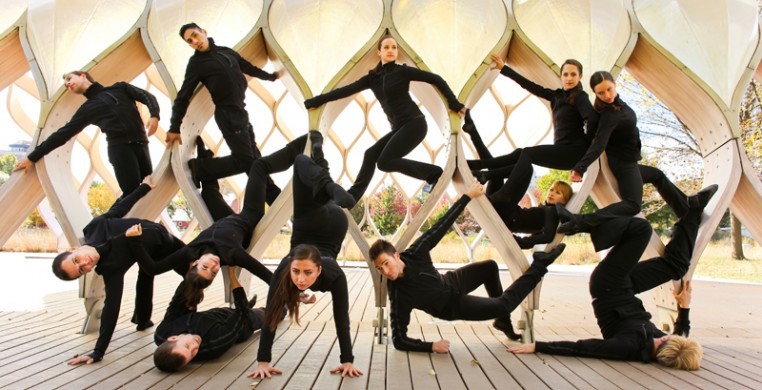The curtain goes up, but only enough to tickle curiosity over the luminous string of human beads clumped across the rim of the stage in Melissa Thodos’ Change of Phase (Chicago premiere). The curtain, suspended no more than three feet off the floor, hovers over a dozen rounded spines. Nothing moves. Suspense builds, until the sound of breath inhaling animates the bodies in slow-rolling compression toward the center of their mass. The squeeze of their combined weight forces vertical expansion of bodies that coalesce in a soft upward explosion of arms, legs, and heads. Breath held, suspended until the audible exhale releases them, the sea-like jelly creatures devolve back to their original state. With each recurring breath they suction a little more life into their many-tentacled shape. Their single-minded dedication first captivates, then amuses, and ultimately teases the audience into joining their delectable game. Just when you begin to wonder where this respiratory exercise will go, organ music rushes in like a wave, the curtain lifts, and the glom of sticky bodies spills into a world of giant corral reef-like structures, designed and built by Jeanne Gang and her Studio Gang Architects.
There is something fundamentally delightful about dance theater that so thoroughly embraces the spirit of discovery, appealing to our innate need to play and to create. Physics meets modern dance in this collaborative work that invites us to imagine actively with the dancers as they explore and negotiate with the pliable white constructs. Shapes and patterns emerge and transform as the dancers bend them, climb onto them, wear them, and build multi-body organisms, sea dinosaurs that move elegantly across the space until they become something else. A mesmerizing stream of humanoid crustaceans swims along the floor with watery ease, propelled by mini skate-boards all but hidden under their stomachs. Quartets of dancers wage spatial war with invisible constraints. Spiral turns and soaring lifts liberate Thodos’ movement and the dancers’ inanimate partners as the constructs sail off the floor and hover overhead in a culmination that begs more.
A Light In The Dark /The Story of Helen Keller and Anne Sullivan (2013) made a welcome return to the Harris, holding up superbly to a second viewing by this reporter. Thodos Dance Chicago is a polished troupe that delivers a compelling performance of this story-ballet, co-choreographed by Thodos and Ann Reinking, and set to original music by Bruce Wolosoff. Thodos and Reinking have done a marvelous job reinventing conventional story-ballet with a continuous flow of strong storytelling in successive scenes through a combination of mostly ballet-based movement, dramatic action, and emotionally riveting segments of interpretive movement. Group scenes, such as the intense, multi-layered family drama at the breakfast table, maximize the power of dance to poignantly transmit Helen’s silent world. Tenley Dorill’s convincing portrayal of Helen was particularly impressive in her ability to convey Helen’s depth of feeling with such innocence and spontaneity in a technically demanding solo following The Cottage Scene. Strong dancing from Annie Deutz as the determined, upright Annie Sullivan, and Brandon Harneck as the tubercular Jimmie Sullivan (Anne’s brother) exemplified specific movement motifs used to define character and relationships. John Cartwright’s spot-on turns and menacing leaps gave substance to the contrary James Keller, Helen’s older brother. While each scene had its own dramatic integrity, one wished for a little more time to let Helen’s monumental discovery and transformation really register in her pivotal revelation at the water pump, but the overall impact of A Light In The Dark remains powerfully moving.
The program included Tsuru (Chicago premiere), by Lucas Crandall, set to an original score by Johnny Nevin, and Panem Nostrum Quoditianum (2013), by Ahmad Simmons.

